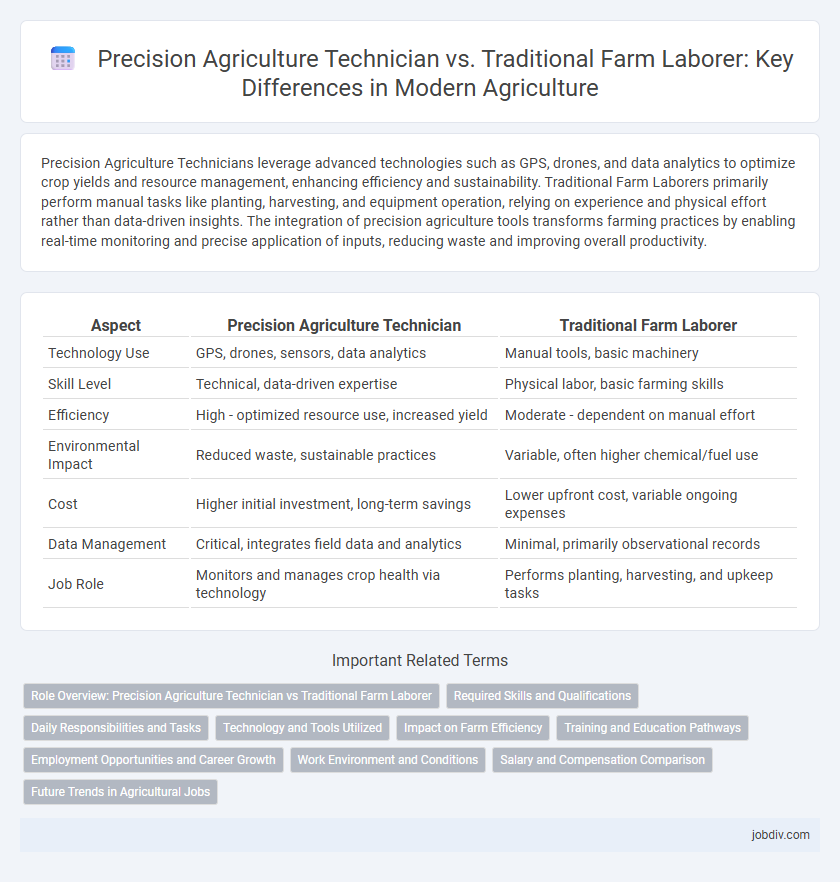Precision Agriculture Technicians leverage advanced technologies such as GPS, drones, and data analytics to optimize crop yields and resource management, enhancing efficiency and sustainability. Traditional Farm Laborers primarily perform manual tasks like planting, harvesting, and equipment operation, relying on experience and physical effort rather than data-driven insights. The integration of precision agriculture tools transforms farming practices by enabling real-time monitoring and precise application of inputs, reducing waste and improving overall productivity.
Table of Comparison
| Aspect | Precision Agriculture Technician | Traditional Farm Laborer |
|---|---|---|
| Technology Use | GPS, drones, sensors, data analytics | Manual tools, basic machinery |
| Skill Level | Technical, data-driven expertise | Physical labor, basic farming skills |
| Efficiency | High - optimized resource use, increased yield | Moderate - dependent on manual effort |
| Environmental Impact | Reduced waste, sustainable practices | Variable, often higher chemical/fuel use |
| Cost | Higher initial investment, long-term savings | Lower upfront cost, variable ongoing expenses |
| Data Management | Critical, integrates field data and analytics | Minimal, primarily observational records |
| Job Role | Monitors and manages crop health via technology | Performs planting, harvesting, and upkeep tasks |
Role Overview: Precision Agriculture Technician vs Traditional Farm Laborer
Precision Agriculture Technicians utilize advanced technologies such as GPS, drones, and data analytics to optimize crop yields and resource management with high accuracy. Traditional Farm Laborers perform manual tasks including planting, cultivating, and harvesting crops, relying primarily on physical labor and experience. The technician's role emphasizes technology-driven decision-making, while the laborer's role focuses on hands-on agricultural work.
Required Skills and Qualifications
Precision Agriculture Technicians require advanced skills in data analysis, GPS technology, and drone operation to optimize crop yields and resource management, whereas Traditional Farm Laborers primarily need physical strength and hands-on experience with planting, harvesting, and equipment maintenance. Technicians often hold specialized certifications or degrees in agronomy, agricultural technology, or engineering, contrasting with farm laborers who generally enter the workforce with minimal formal education but substantial practical knowledge. Mastery of software platforms like GIS and IoT devices is essential for Precision Agriculture roles, highlighting a shift towards technology-driven expertise in farming operations.
Daily Responsibilities and Tasks
Precision agriculture technicians utilize GPS technology, drones, and soil sensors to analyze crop health and optimize planting patterns, enhancing yield efficiency. Traditional farm laborers perform manual tasks such as planting, weeding, harvesting, and operating basic farm machinery to maintain crop production. Precision technicians focus on data collection and equipment calibration, while laborers handle physically intensive, repetitive fieldwork.
Technology and Tools Utilized
Precision Agriculture Technicians utilize advanced technologies such as GPS-guided equipment, drones, and soil sensors to optimize crop management and increase efficiency. In contrast, Traditional Farm Laborers rely primarily on manual labor and basic tools like hand-held implements and tractors without integrated digital systems. The integration of data analytics and automation in precision agriculture significantly enhances productivity and resource management compared to conventional farming methods.
Impact on Farm Efficiency
Precision agriculture technicians utilize GPS-guided equipment, drones, and data analytics to optimize planting, irrigation, and harvesting, significantly enhancing farm efficiency by reducing resource waste and boosting crop yields. Traditional farm laborers rely on manual labor and conventional methods, which often result in lower productivity and higher input costs due to less precise application of resources. Integration of precision technologies leads to improved decision-making and operational efficiency, transforming farm management practices.
Training and Education Pathways
Precision Agriculture Technicians require specialized training in GPS technology, data analysis, and drone operation, typically obtained through associate degrees or technical certifications. Traditional Farm Laborers often enter the workforce with minimal formal education, gaining skills through hands-on experience and seasonal work. The growing demand for technology-driven solutions in agriculture emphasizes the importance of formal education and continuous learning for precision roles.
Employment Opportunities and Career Growth
Precision agriculture technicians benefit from growing demand fueled by advancements in GPS, drones, and data analytics, creating diverse employment opportunities in smart farming sectors. Traditional farm laborers continue to hold essential roles in manual crop cultivation and harvesting, but face limited career growth due to mechanization and automation trends. Skills in digital tools, agronomy data interpretation, and equipment maintenance significantly enhance long-term career prospects for precision agriculture professionals.
Work Environment and Conditions
Precision Agriculture Technicians work in technology-driven environments, utilizing GPS, drones, and data analytics to monitor crop health and optimize resource use, often spending time both indoors analyzing data and outdoors operating advanced machinery. Traditional Farm Laborers primarily engage in physically demanding tasks outdoors, exposed to varying weather conditions and manual labor such as planting, harvesting, and equipment maintenance. The shift toward precision agriculture enhances efficiency, reduces physical strain, and improves environmental sustainability compared to the more labor-intensive and weather-dependent conditions faced by traditional farmworkers.
Salary and Compensation Comparison
Precision Agriculture Technicians earn an average annual salary ranging from $45,000 to $70,000, reflecting specialized skills in GPS technology, data analysis, and machinery operation, significantly higher than Traditional Farm Laborers who typically earn between $25,000 and $35,000 annually. Compensation packages for Precision Agriculture Technicians often include benefits such as health insurance, paid leave, and performance bonuses, whereas Traditional Farm Laborers may receive limited benefits and primarily hourly wages. The increasing demand for technological expertise in modern farming continues to drive up salaries and career growth opportunities for Precision Agriculture Technicians compared to traditional roles.
Future Trends in Agricultural Jobs
Precision agriculture technicians utilize advanced technologies such as GPS, drones, and data analytics to optimize crop yield and resource management, reflecting the growing role of smart farming technologies in agriculture. Traditional farm laborers continue to provide essential manual labor but face a shift as automation and robotics increase efficiency and reduce demand for repetitive tasks. Future agricultural jobs will prioritize digital skills, remote monitoring, and sustainable practices, blending technology expertise with traditional farming knowledge to meet global food production challenges.
Precision Agriculture Technician vs Traditional Farm Laborer Infographic

 jobdiv.com
jobdiv.com